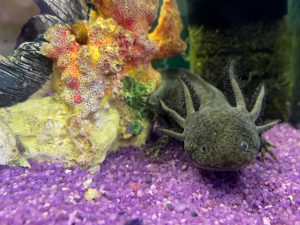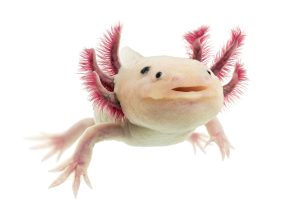Hidden within the freshwater canals and lakes of Mexico lies a creature of incredible fascination and intrigue—the axolotl (Ambystoma mexicanum).

Axolotl Mexican underwater walking fish salamander in aquarium
This enigmatic Mexican salamander has captured the attention of scientists and nature enthusiasts worldwide due to its extraordinary abilities and peculiar characteristics. In this article, we will dive into the captivating world of the axolotl, exploring its unique biology, regenerative powers, and its importance in scientific research.
Appearance and Adaptations:
The axolotl boasts a distinct appearance, characterized by its feathery external gills, elongated body, and fringed dorsal fin. Unlike most amphibians, the axolotl remains permanently aquatic, never undergoing metamorphosis to a terrestrial form. Its slender limbs are equipped with long, delicate digits, enabling it to gracefully navigate its aquatic habitat.
One of the most intriguing aspects of the axolotl’s biology is its remarkable regenerative capabilities. It has the extraordinary ability to regrow lost body parts, including limbs, spinal cord, heart tissue, and even portions of its brain. This regenerative power has made the axolotl a subject of intense scientific interest, holding the potential for breakthroughs in the field of regenerative medicine.
Habitat and Distribution:
The axolotl is native to the Xochimilco and Chalco regions of Mexico, primarily inhabiting the complex system of freshwater canals, lakes, and wetlands in and around Mexico City. These unique aquatic habitats provide the axolotl with the ideal conditions for survival, including a steady supply of food and suitable temperature ranges.
Threats and Conservation Efforts: Unfortunately, the axolotl population has experienced a drastic decline in recent decades due to several factors, including habitat loss, pollution, and the introduction of non-native species. The draining and pollution of its natural habitat, as well as the illegal pet trade, have significantly impacted the species.
Conservation efforts are underway to protect the axolotl and restore its dwindling population. Initiatives include habitat restoration, captive breeding programs, and educational campaigns to raise awareness about the importance of preserving this unique species.
Scientific Significance:
The axolotl holds immense scientific value, particularly in the field of regenerative biology. Its ability to regenerate complex body parts has fascinated researchers, providing valuable insights into the processes of tissue regeneration and wound healing. Studying the axolotl’s regenerative abilities may hold the key to unlocking new approaches for treating injuries and diseases in humans.

Axolotl (Ambystoma mexicanum)
Beyond its regenerative powers, the axolotl’s unique genetic makeup also provides valuable insights into evolutionary biology and developmental processes. Scientists continue to unravel the mysteries of its genome, which contains a wealth of information that may hold implications for human health and understanding the complexities of life itself.
Cultural Significance:
The axolotl holds a special place in Mexican culture and mythology. Revered by the Aztecs as a symbol of transformation and renewal, the axolotl has become an icon of Mexican heritage. Its striking appearance and remarkable abilities have captured the imagination of artists, writers, and storytellers, further cementing its cultural significance.
Conclusion:
The axolotl stands as a captivating testament to the wonders of the natural world. With its remarkable regenerative powers, unique biology, and cultural significance, it represents a fascinating intersection of science and mythology. By preserving its fragile habitat and supporting conservation efforts, we can ensure the survival of this extraordinary Mexican salamander and continue to unlock the secrets it holds, potentially transforming our understanding of regenerative medicine and the mysteries of life itself.


